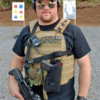We should all know and be well-versed with the four weapons safety rules:
- Treat every weapon as if it is loaded.
- Never point a firearm at anything that you are not willing to destroy.
- Keep your finger straight and off the trigger until you have consciously made the decision to fire.
- Always know your target, backstop and beyond.
Why do we keep our finger straight and off the trigger until we have consciously made the decision to fire? There are a few concepts that can cause us to have a negligent discharge. These should be understood in conjunction with this specific weapons safety rule.
The first concept is called Postural Instability. A self-defense situation is a high stress scenario; in this type of circumstance you can experience things like tunnel vision, auditory exclusion and full sensory overload. If you are having to move to cover or if you are trying to retreat to a safe location and await help, or if you slip on something or trip because you are experiencing tunnel vision, your first natural response is going to be to tense up. If your finger is on the trigger and you tense up, you could exert enough pressure on the trigger to discharge a round.
The second concept is called Startle Response. Again, if you are in a defensive situation and you are trying to retreat to a safe location and await help, if you are startled your natural response will be to tense up. If you are moving with your finger on the trigger and you tense up due to being startled, you could again exert enough pressure on the trigger to discharge a round.
The third concept is Overflow Effect. Overflow effect is that when you apply pressure with one hand, the body will naturally transfer energy to the opposite hand and pressure will inadvertently be applied subconsciously. So if we look at the same scenario above, if you are moving through an area and you squeeze a doorknob with your non-dominant hand; if your firearm is in your dominant hand with your finger on the trigger you could inadvertently exert enough pressure to discharge a round.
As a general rule of thumb, an unintentional but well-placed shot, regardless of the intentions, is often just as bad as an intentionally well-placed shot with bad intentions. What this refers to is the fact that you are responsible for every round you fire, until that round stops. If you inadvertently discharge a round and hit an innocent bystander, you are still responsible for that action. It is because of this that we must always follow the four weapons safety rules.


